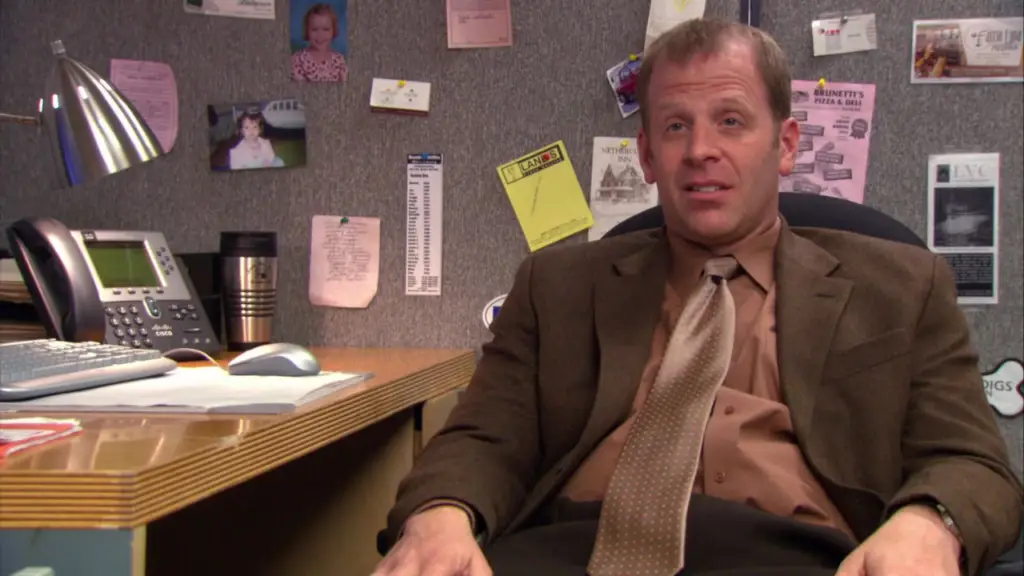For fans of The Office, the Scranton Strangler remains one of the most mysterious subplots in the series. Although George Howard the Scranton Strangler is officially convicted as the Strangler, some fans speculate that Toby Flenderson, the mild-mannered HR representative, might have been the real culprit. Let’s examine the evidence and explore five compelling examples that have fueled this theory.
1. Toby’s Obsession with the Case
One of the most intriguing and debated theories about the Scranton Strangler centers on Toby Flenderson, whose peculiar behavior and emotional investment in the case have sparked widespread speculation among fans. A standout moment occurs when Toby, who served on the jury that convicted the alleged Scranton Strangler, begins to question the verdict. In a rare display of vulnerability, he confesses that the jury “may have put an innocent man behind bars.” This admission has led some to view his fixation on the case as more than mere curiosity—potentially as a reflection of personal guilt or involvement.
Psychologically, it’s not uncommon for perpetrators to stay close to investigations into their crimes, either to deflect suspicion or to relive the adrenaline of their actions. Toby’s obsession with the case fits this profile and adds a layer of suspicion. His repeated, unsolicited commentary about the trial and its outcome stands out, especially when juxtaposed with his otherwise mild and reserved personality.
Adding further intrigue is Toby’s tone and demeanor whenever the Scranton Strangler is discussed. His moments of doubt are laced with an intensity that feels unusually personal. Some fans interpret his anguish as more than a conscientious juror grappling with a possible miscarriage of justice. Instead, they see it as a sign of internal conflict—perhaps guilt over his own actions being projected onto the outcome of the trial.
While the writers of The Office never confirmed or denied this fan theory, the clues scattered throughout the series have kept viewers speculating. Whether it’s Toby’s fixation on the case, his odd behavior during pivotal moments, or subtle hints from his interactions with others, the theory that he could be the Scranton Strangler remains one of the most fascinating mysteries of the show.
2. Toby’s Personality and Loneliness
Toby Flenderson is consistently depicted as a loner within the dynamics of The Office. Socially awkward and often struggling to form meaningful connections, Toby’s interactions with his coworkers are limited and often strained. His unreciprocated feelings for Pam further emphasize his isolation, painting a picture of a man who longs for connection but lacks the confidence or opportunity to attain it. This portrayal aligns with research on serial offenders, which suggests that many individuals who commit violent crimes lead isolated lives. Such isolation can intensify feelings of anger, frustration, or despair, potentially fueling destructive behaviors.
Adding to Toby’s psychological struggles is his frequent mistreatment by Michael Scott, the Dunder Mifflin Scranton branch manager. Michael openly derides Toby, belittling him in front of their coworkers and dismissing his contributions. This relentless ridicule creates an environment where Toby’s emotions remain unaddressed and his frustrations are allowed to fester. Workplace ostracism and bullying have been shown to have profound psychological effects, often exacerbating feelings of inadequacy or resentment.
One poignant example of Toby’s struggles is seen in the episode where he returns from Costa Rica. What was intended as a hopeful escape to paradise ends in disappointment, with Toby returning to Scranton physically injured and emotionally defeated. His lack of assertiveness and visible frustration with his mundane life are particularly striking in this episode. These moments of suppressed emotions—whether anger, longing, or disillusionment—have been cited by fans as psychological red flags.
The theory that Toby could harbor darker impulses stems from these unaddressed struggles. Fans speculate that his inability to express his frustrations in healthy ways might lead him to seek drastic outlets for his internal turmoil. While this remains a fan theory with no definitive evidence in the show, the parallels between Toby’s isolation and mistreatment and the behavioral patterns observed in serial offenders add an unsettling layer to his character’s arc.
3. Toby’s Absences and the Timeline of Stranglings
Although The Office does not provide a fully fleshed-out timeline of events, observant fans have drawn intriguing connections between Toby Flenderson’s absences and key developments in the Scranton Strangler case. One of the most discussed moments is Toby’s leave of absence to serve on the jury during the trial of the Scranton Strangler. While this is initially presented as a mundane civic duty, fans have pointed out the curious coincidence: the Strangler’s criminal activity seemingly halts around the time Toby is called to serve on the jury. This overlap has been interpreted as potential circumstantial evidence suggesting a connection between Toby and the crimes.
The timing raises further questions when considering Toby’s behavior upon returning to the office after the trial. He exhibits a noticeable shift in demeanor, appearing more subdued and introspective than usual. His comments about potentially convicting an innocent man suggest an internal struggle that fans have speculated could stem from a deeper, more personal burden. This change has been viewed by some as evidence of guilt or psychological distress related to the case.
Adding to the timeline theory is another striking coincidence: Toby’s return to Scranton after an extended leave in Costa Rica coincides with the onset of the Scranton Strangler’s spree. In the series, Toby’s Costa Rican escape is framed as a failed attempt to find personal fulfillment, ending in physical injury and a defeated return to his old life. However, fans have proposed that the timing of his return could mark the beginning of his involvement as the Strangler.
These overlapping timelines, while never explicitly addressed in the show, have become a focal point for those examining the theory that Toby might be the Scranton Strangler. While the evidence remains circumstantial, the alignment of these events—his jury duty, the cessation of the Strangler’s crimes, and his behavioral changes—adds fuel to a theory that continues to intrigue and entertain fans of the series.
4. The Car Chase
In the The Office episode “Viewing Party,” the staff gathers in the conference room to watch the televised police chase of the Scranton Strangler, an event that has captivated the town. While the rest of the office is fully engaged in the excitement, reacting with shock, concern, and even humor, Toby Flenderson’s response is notably subdued.
He remains eerily quiet throughout the scene, showing little to no outward emotion in contrast to his colleagues, who are visibly riveted by the spectacle. This unusual behavior has led fans to speculate about Toby’s possible connection to the case, with some interpreting his lack of reaction as an attempt to avoid drawing attention to himself.
Toby’s apathy in this moment stands out for several reasons.
First, the Strangler case is one that he has shown a significant interest in throughout the series, particularly during his time on the jury.
His early doubts about the Strangler’s guilt, combined with his apparent emotional investment in the trial, make his lack of excitement during the chase seem inconsistent with his previously demonstrated curiosity.
Unlike his coworkers—who laugh, gasp, and comment on the chase—Toby remains almost completely detached, which raises the question: why is he so indifferent?
One possible explanation is that Toby already knows the outcome of the chase, which would certainly explain his restrained behavior. If Toby were somehow involved in the Strangler’s crimes, it would make sense that he would act nonchalantly, having no need to feign surprise or concern like the others. His quiet demeanor could, in fact, be a strategic move to avoid suspicion.
Moreover, Toby’s peculiar reaction also opens the door to a more unsettling theory: that Toby might have been in some way connected to orchestrating the events leading up to the televised chase. Given his role in the case, it’s not far-fetched to consider that he may have had prior knowledge of the chase’s details or even been nearby as events unfolded. This idea, though speculative, would align with the darker fan theory that Toby is somehow complicit in the Strangler’s actions, rather than merely an innocent bystander.
Ultimately, this scene in “Viewing Party” is a subtle but powerful example of how Toby’s behavior can be read as a clue in the broader mystery surrounding the Scranton Strangler. His detached response stands in stark contrast to his coworkers’ reactions and fuels the ongoing fan theories about his involvement in the case.
5. Toby’s Behavior Post-Trial
After the trial of the Scranton Strangler, Toby Flenderson visits the convicted man in prison, recounting a chilling encounter in which he claims he was nearly strangled by the very individual convicted of the crimes.
On the surface, this visit might seem like a straightforward effort to distance Toby from the case, especially considering the possibility that he may have harbored doubts about the man’s guilt. However, upon closer examination, the visit could also be interpreted as a calculated move to discredit the Scranton Strangler and solidify his conviction. For Toby, the visit might have offered a sense of control or closure, particularly if he was trying to ensure the man remained incarcerated for crimes that Toby himself could have been responsible for.
The context of Toby’s visit adds to the suspicion. His decision to personally confront the man who took the fall for the Strangler’s crimes could be viewed as an attempt to reinforce the public’s belief in the Strangler’s guilt. By presenting himself as a victim in the narrative, Toby could be working to strengthen the case against the convicted man, ensuring that any lingering doubts about the Strangler’s culpability were minimized. This action would fit with the psychological profile of someone trying to maintain control over a situation they have secretly orchestrated.
What makes Toby’s retelling of the encounter even more suspicious is the lack of detail in his version of events. Despite claiming that the Strangler nearly strangled him, Toby’s account is oddly nonchalant and strikingly vague. He provides no specifics about the circumstances surrounding the alleged attack or how it unfolded, which seems odd for someone recounting such a dramatic incident. His failure to offer any concrete details has led some fans to speculate that the story was fabricated, possibly as an attempt to divert attention away from himself and avoid drawing further scrutiny.
If Toby were, in fact, the Scranton Strangler, this visit to the prison could be seen as a deliberate effort to manipulate public perception. By visiting the convicted man, who is now associated with the crimes, and sharing a tale of near-victimhood, Toby could have been attempting to solidify the Strangler’s guilt in the minds of others while diverting suspicion away from himself. In this light, the encounter takes on a more sinister undertone—what might seem like an innocent visit could, in fact, be a calculated part of a broader strategy to protect Toby’s secret and maintain the Strangler’s false identity.
This visit, and the dubious details of Toby’s story, fuel the growing fan theories that suggest Toby’s involvement in the crimes may go far beyond simple juror doubt or guilt. Rather, it could be part of an elaborate effort to control the narrative, keeping the true identity of the Strangler hidden and Toby’s role in the crimes safely obscured.
Counterarguments
While the theory suggesting Toby Flenderson’s potential involvement in the Scranton Strangler case is certainly compelling, it’s crucial to consider several counterarguments that challenge this interpretation.
First and foremost, Toby’s overall characterization throughout The Office leans heavily toward passivity and timidity, which starkly contrasts with the aggressive and controlling traits typically associated with violent offenders, including serial killers.
Toby is frequently depicted as a passive, somewhat ineffectual character who struggles to assert himself, especially in the face of conflict. His lack of assertiveness is evident in his personal and professional life, from his inability to express his romantic feelings for Pam to his meek response to Michael Scott’s constant bullying.
Such characteristics don’t align with the psychological profile of someone capable of committing violent crimes, particularly over an extended period. Instead, they suggest a man who is more likely to internalize his frustrations than act them out in violent ways.
Additionally, the satirical and comedic nature of The Office plays a crucial role in how the show presents its characters and plotlines. The series, known for its deadpan humor and absurd situations, often incorporates elements that are intentionally exaggerated or meant to be taken lightly.
The Scranton Strangler subplot, while intriguing, is presented within the context of the show’s broader comedic tone, which includes its portrayal of quirky office dynamics, farcical scenarios, and exaggerated character behaviors. It’s highly likely that the Strangler storyline was never intended to withstand intense scrutiny or be examined as seriously as some fans have done.
The subplot is likely more of a comedic device—a running joke that plays on the absurdity of office gossip and the characters’ general lack of self-awareness—rather than a complex mystery that demands detailed analysis.
Furthermore, moments that fans interpret as signs of Toby’s potential guilt, such as his awkward silences or subdued reactions, may simply be instances of his chronic discomfort and social anxiety. Toby’s tendency to remain quiet or appear uncomfortable in stressful situations is a central aspect of his character throughout the series.
His reticence and lack of outward expression could easily be explained by his general unease in social settings, particularly in a high-stakes moment like the Scranton Strangler chase.
Toby’s awkwardness and inability to express his emotions in healthy ways are recurring traits that have been established over the course of the show. These characteristics might explain his peculiar reactions without implying any nefarious intent or criminal behavior.
Ultimately, while the theory about Toby being the Scranton Strangler is a compelling exercise in fan speculation, it may overstate the significance of moments that are, in reality, reflective of his ongoing character development as a socially awkward and passive individual.
In light of the show’s comedic tone and Toby’s established personality traits, the idea that Toby is a criminal mastermind may be an over-interpretation of the subtle cues in his behavior, rather than an indication of hidden guilt or involvement in a series of crimes.
Conclusion
The theory that Toby Flenderson could be the Scranton Strangler offers a compelling and thought-provoking perspective on The Office, inviting viewers to reconsider the seemingly innocuous behavior of a character often overlooked in the broader dynamics of the show.
While the theory is based largely on circumstantial evidence—such as Toby’s unusual interest in the case, his moments of emotional detachment, and the odd timing of his absences—there is no definitive proof to suggest that Toby is, in fact, the Strangler. Nonetheless, his peculiar actions and the numerous coincidences woven throughout the show make him a fascinating subject of fan speculation.
Key pieces of evidence, such as Toby’s role in the jury that convicted the Scranton Strangler and his seemingly strange behavior during moments tied to the case, provide intriguing points for analysis. His subdued reactions, his questionable interactions with the convicted man, and his emotional shifts suggest a complex inner life that, if read through a certain lens, could hint at darker motivations.
The ambiguity of Toby’s character—particularly his passive nature, awkwardness, and the occasional emotional outbursts—leaves room for interpretation, allowing fans to construct their own theories about his potential involvement in the crimes.
That said, it’s essential to recognize that The Office is, at its core, a comedic series with a satirical take on everyday office dynamics. The Scranton Strangler subplot, though intriguing, was likely never meant to be dissected to the extent it has been by fans.
The show’s humor often relies on exaggerated, absurd situations, and Toby’s character is frequently portrayed in a lighthearted, almost tragicomic way. His awkwardness, internal struggles, and frequent mistreatment by his colleagues fit within the broader theme of the show’s quirky and flawed characters, rather than pointing to a hidden criminal mastermind.
Whether one subscribes to the theory that Toby is the Scranton Strangler or dismisses it as an overanalysis of a fictional character’s quirks, the mystery of the Strangler remains a captivating aspect of The Office lore. This unresolved subplot taps into the show’s larger themes of uncertainty, misunderstanding, and the absurdity of everyday life.
It also speaks to the power of fan engagement, where even the smallest details of a show can spark broad speculation and create rich layers of interpretation. Ultimately, the enduring allure of the Scranton Strangler mystery lies in its ability to keep fans questioning and re-examining the familiar, adding depth to an already beloved show.
What do you think? Could Toby have a dark secret, or is this theory just another fan-fueled fantasy? Let us know in the comments.



